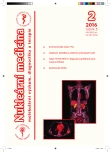Match V/Q defect in pulmonary embolism
Authors:
Otto Lang; Ivana Kuníková
Authors‘ workplace:
Klinika nukleární medicíny, 3. LF UK a FNKV, Praha 10, ČR
Published in:
NuklMed 2016;5:37-38
Category:
Overview
25-y-old lady was sent to lung perfusion scintigraphy due to worsening dyspnea and chest pain on inspiration. There were repetitive pneumonias and contraceptive intake in her history. Chest X-ray was without pathology. Lung perfusion scintigraphy performed with 99mTc-macroaggregated albumin (MAA) pointed a large reduction of MAA accumulation in the left lower lobe and another smaller one in the right lower lobe (Fig. 1); it was interpreted as a pulmonary embolism (PE). Ventilation scintigraphy was recommended due to pneumonia in her history and not completely typical clinical picture. It was performed 2 days later due to logistic difficulties. It was performed with 99mTc-labeled DTPA aerosol and confirmed non-homogenous ventilation with implied central deposition of aerosol and also reductions corresponding to perfusion changes. (Fig. 2) Perfusion-ventilation scintigraphy was, therefore, reinterpreted as a pattern not consistent with PE. Patient was nevertheless treated with anticoagulants based on clinical decision and she was sent to follow-up lung perfusion scan 5 months later. This examination demonstrated normalization of previous perfusion changes (Fig. 3) and confirmed thus correct interpretation of the initial perfusion scan. This examination emphasizes the importance of performing ventilation scan within 24 hours of perfusion scan because lung ventilation is later on also reduced in the area of embolism. Therefore, the interpretation of ventilation perfusion scan at this case could be false negative as to pulmonary embolism because of match pattern.
Key words:
pulmonary embolism, lung ventilation perfusion scintigraphy, time interval
Sources
1. Miniati M, Sostman HD, Gottschalk A, et al. Perfusion lung scintigraphy for the diagnosis of pulmonary embolism: reappraisal and review of the PISAPED method. Sem Nucl Med 2008;38 : 450–4611
2. Bajc M, Neilly JB, Miniati M, et al: EANM guidelines for ventilation/perfusion scintigraphy. Eur J Nucl Med Mol Imaging 2009;36 : 1356-1370
3. Reid JH, Coche EE, Inoue T, et al. Is the lung scan alive and well? Facts and controversies in defining the role of lung scintigraphy for the diagnosis of pulmonary embolism in the era of MDCT. Eur J Nucl Med Mol Imaging 2009;36 : 505–521
4. Wagner HN Jr, Sabiston DC Jr, McAfee JG, et al. Diagnosis of massive pulmonary embolism in man by radioisotope scanning. N Engl J Med 1964;271 : 377–384
Labels
Nuclear medicine Radiodiagnostics RadiotherapyArticle was published in
Nuclear Medicine

2016 Issue 2
Most read in this issue
- 18F-FDG PET/CT pitfalls in the diagnostic work-up of inflammation of unknown origin
- Effectiveness of axillar sentinel lymph node detection
- Match V/Q defect in pulmonary embolism
- Quality control of 223Ra eluate
